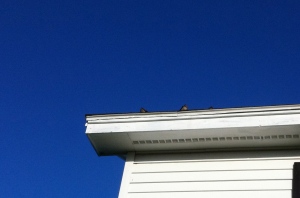
I know they’re hard to see, but there are three baby barn swallows on our roof. For the past week we’ve been hosting flight school. Our neighbor’s barn swallows sail all over our yard calling (begging too) and presumably snatching up bugs. When the babies tire, they rest on the roof and beg some more. The parents zoom by and feed them.
Bobolinks
I’ve been holding off posting this, but I think it’s safe to say the bobolinks have made it this year, assuming their nests didn’t wash out during all the rain. The hay, more golden each day, still stands. The birds are skulking in their grassland forest, no longer perched on swaying tips singing their crazy R2D2 song. It’s getting quieter by the day as other birds finish breeding too. The robins are still up at 4:30 proclaiming their joy–or at least their address–to all the other robins in hearing distance. The phoebe, who is househunting for a second brood, is right behind him along with the common yellow throat (witchety witchety witchety). The savannah sparrows chime in a little later, but by 6, things have really settled down. On my bike rides I’m still hearing plenty of warblers, but I know we’re past the peak.
Our tree swallows and bluebirds are working their wings off trying to launch their broods. They should fledge within the week.
The bobolinks have stopped singing altogether. Usually it’s more of a tapering off of song as though some invisible hand is turning down the volume. But this year, it was more like someone pressed the power button and shut off the whole show. I think that’s OK. I think it means the bobolinks are no longer so much under the influence of raging hormones and are putting more energy into molting. They must replace their flight feathers for the long trip back to the Pampas where they winter. I can still see their heads when they surface above the canopy, and I can hear their distinctive “check” call in the grass–listening to them right now as a matter of fact–but no more bubbling arias.
The hay, meanwhile, is magnificent, though I know farmers are ready to weep. Though they used to hay in July in the past (which helped grassland birds maintain their populations) science now tells us each day the hay loses nutrition and farmers’ costs rise (they must find other hay or feed expensive grain). I may regret this when I buy meat or dairy products later this year, but for now all I can say is wave on.

Loved this. I love Bobolinks for their name alone. You have a gift for describing the world of birds.
Thank you 🙂
This is beautiful, Julia. I think Tom would really enjoy your blog too–I certainly am hooked!
Thanks Ren for all your kind words 🙂